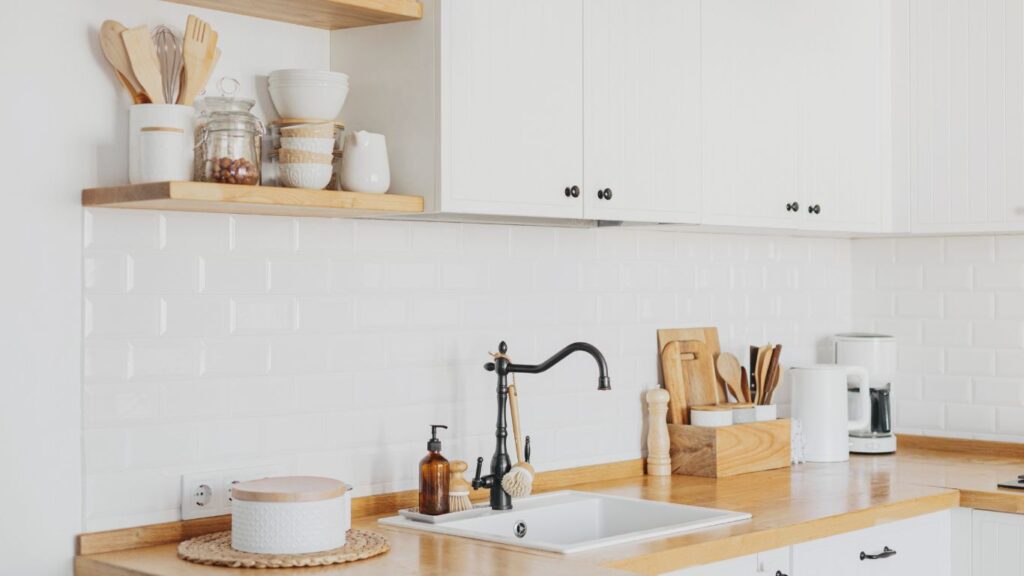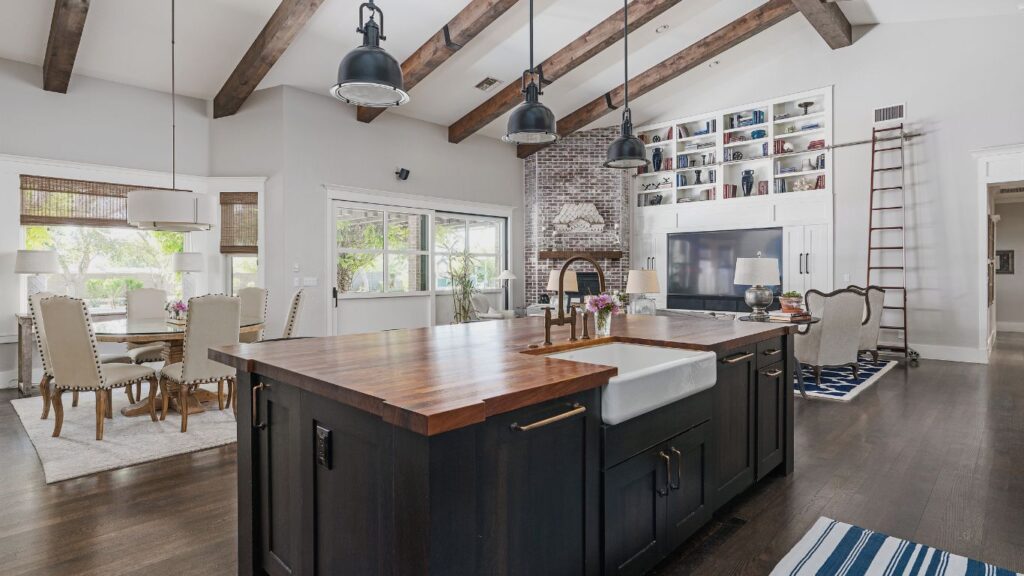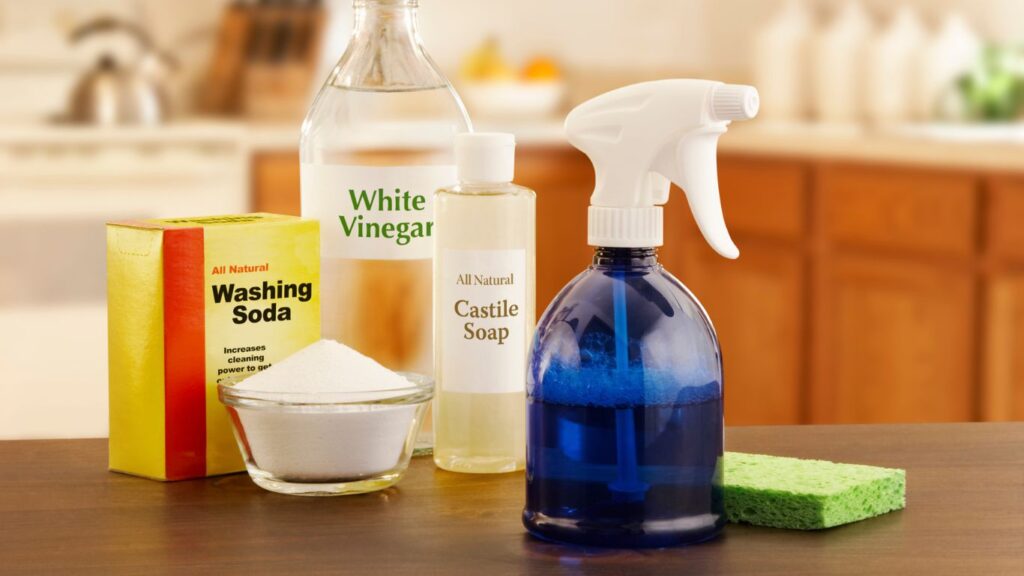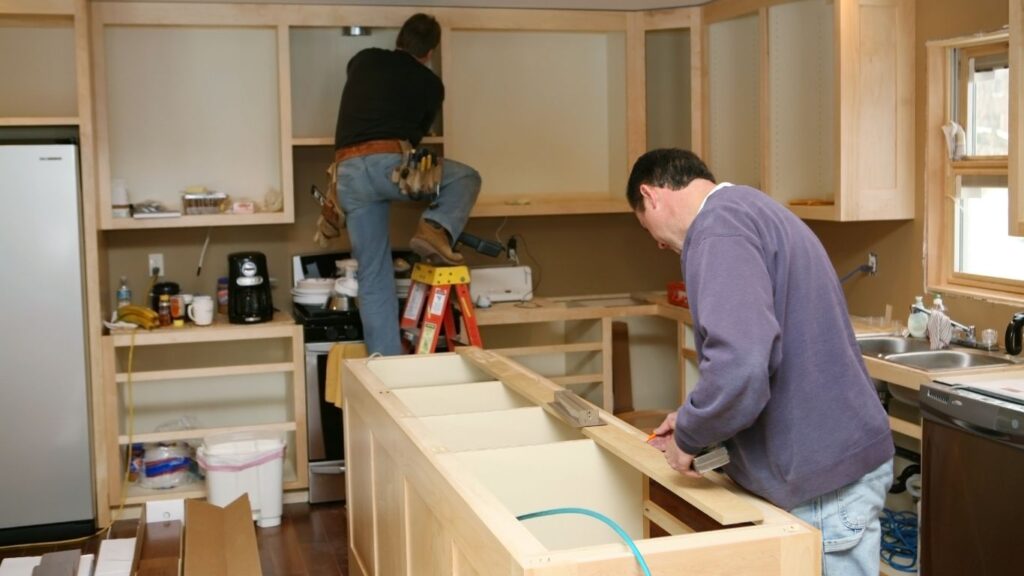If you’re reading this, chances are you’re interested in creating an eco-friendly kitchen design for your home. I know how you feel. I’ve been there too. I wanted to make my kitchen more beautiful, functional, and sustainable, but I didn’t know where to start. There were so many options, so many factors, and so many challenges. That’s why I decided to write this guide for you.
In this guide, you’ll learn everything you need to know about eco-friendly kitchen design, from the importance of choosing suitable materials and appliances to the design ideas and tips that will make your kitchen look fantastic and save the planet at the same time. You’ll also hear about my personal experiences and challenges in creating my eco-friendly kitchen design and the answers to some of the most frequently asked questions.
So, are you ready to join me on this journey? Let’s get started!
Table of Contents
Importance of Creating an Eco-Friendly Kitchen Design

As we strive towards a sustainable future, we must consider environmentally-friendly designs in all our lives. The kitchen, being a critical space in our homes, is no exception. Creating an eco-friendly kitchen design reduces our carbon footprint and offers numerous health benefits.
An essential aspect of an eco-friendly kitchen design is using sustainable countertops, cabinets, and flooring materials. Bamboo, reclaimed wood, and recycled glass are great options for countertops and cabinetry, while linoleum or cork makes excellent flooring choices. These materials reduce waste and production pollution.
Another way to create an eco-friendly kitchen design is by investing in energy-efficient appliances like stoves, refrigerators, and dishwashers. These appliances consume less energy and require less water than standard appliances. LED lights should also be used instead of traditional incandescent bulbs as they are durable and use less energy.
To further minimize waste in the kitchen, homeowners can integrate composting bins into their design. Composting food scraps helps to decrease greenhouse gas emissions from landfills while serving as nutrient-rich soil for plants.
Finally, incorporating indoor plants into the kitchen’s decor enhances the room’s aesthetic appeal while improving air quality by reducing humidity and eliminating toxic chemicals.
In summary, creating an eco-friendly kitchen design can profoundly impact our environment and health. By using sustainable materials, energy-efficient appliances, composting correctly, and adding indoor plants, one can ensure that their kitchen looks beautiful and is suitable for the planet.
Factors to Consider in Making an Eco-Friendly Kitchen Design

To make your kitchen design beautiful and eco-friendly, consider some key factors. With the right tricks, you can create a stylish kitchen that’s also gentle on the environment. Choosing sustainable materials and reducing energy and water consumption are the top sub-sections of an eco-friendly kitchen design.
Choosing Sustainable Materials
Choosing sustainable and environmentally friendly materials is crucial when creating an eco-friendly kitchen design. Opting for non-toxic and renewable options can significantly impact the environment. Using natural materials like bamboo, cork, and wheat board in flooring, counters, cabinets, etc., offers a variety of energy-efficient options that make kitchen sustenance more natural and environmentally sound.
Choosing sustainable material ensures your kitchen renovation project adheres to green design principles while preserving the environment. Reclaimed wood or recycled glass countertops could be used that offer unique character and style with minimal environmental impact. Low VOC paint emitting fewer harmful compounds into the air than traditional paint helps maintain indoor air quality.
It is essential to consider the life cycle of products while designing a sustainable kitchen, reducing waste by reusing plastics to reduce overall emissions while offering captivating designs for countertops or backsplashes. Reducing resource consumption in raw material extraction and production processes by choosing energy-efficient kitchen appliances.
Pro Tip: When selecting sustainable materials for your eco-friendly kitchen remodel, seek high-quality products that will endure regular use without frequent repairs or replacements.
Saving the planet never looked so good – mainly when it’s reflected in your lower energy bills.
Reducing Energy Consumption
One way to promote an eco-friendly kitchen design is by using energy-efficient strategies. The following points present some ideas that can help reduce kitchen energy consumption.
- Use energy-efficient appliances: Choose home appliances with an Energy Star rating, as they consume less electricity while doing their job.
- Install LED lights: Switch traditional incandescent lamps for LED lights that use less power and increase efficiency.
- Optimize natural light: Use windows or skylights to maximize daylight and minimize artificial lighting usage.
- Incorporate timed switches or motion sensors: Install these devices to switch off unnecessary lights and fans when not in use.
Apart from these tips, other options are available for the kitchen, like installing water-saving faucets or monitoring idle electricity consumption. To craft an eco-friendly kitchen, include all possible aspects in the plan, from material selection to fixture installation.
Pro Tip: Properly selecting insulation materials helps maintain a consistent temperature, especially around pipework and drainage channels, to save on heating/cooling expenses.
Saving water in the kitchen preserves the planet and helps you avoid awkward small talk with your plumber.
Reducing Water Consumption
One of the primary considerations when designing an environmentally-friendly kitchen is reducing water usage. To accomplish this, homeowners can install high-efficiency faucets and dishwasher appliances that use less water but still provide the same level of functionality. Additionally, choosing low-flow showerheads and toilets can help reduce overall water consumption in the home.
It is also essential to consider the water filtration system in the kitchen. Homeowners can opt for eco-friendly filters that purify the water without harsh chemicals or additives. Installing sensors on faucets to help ensure that they are not left running unnecessarily can also help minimize water wastage.
Lastly, incorporating indoor plants into the kitchen design can make it more comfortable while reducing overall air pollution. Some popular options include English Ivy, Peace Lily, Weeping Fig, and Spider Plant.
Transforming a standard kitchen into an eco-friendly doesn’t have to be expensive or complicated. It often simply involves making small changes like those mentioned above.
Want to save the planet and impress your guests? Check out these eco-friendly kitchen design ideas that are both chic and Earth-approved.
Ideas for an Eco-Friendly Kitchen Design

To create an eco-friendly kitchen, you must consider various design ideas to make your kitchen beautiful and environmentally friendly. Incorporating natural lighting, maximizing natural ventilation, adding indoor plants, using recycled and upcycled materials, and opting for energy-efficient appliances are some excellent options for making an eco-friendly kitchen design. These ideas can help you save energy, reduce waste, and create a healthier home environment.
Incorporating Natural Lighting
One way to enhance the green design of your kitchen is to introduce elements of eco-friendly natural lighting. By optimizing the amount of sunlight entering your kitchen, you can both decrease energy costs and create an inviting atmosphere. Adding large windows or skylights can transform a dim space into one that’s bright and welcoming.
You could also utilize lighter shades for walls and cabinets to reflect more light. Such adjustments will reduce the need for artificial light and uplift your kitchen’s design.
To make natural lighting even more effective, consider adding movable blinds or curtains that can be used to control the brightness. These can allow you to leverage natural lighting while limiting glare and heat entry within the space.
Maximizing Natural Ventilation
To improve the environmental credentials of your kitchen, natural ventilation can be maximized. Using environmentally friendly materials can reduce energy consumption and minimize carbon emissions.
Installing roof vents and strategically placing windows can create a natural airflow that reduces the need for mechanical ventilation. This also helps to keep the space more relaxed in the summer months and limits moisture build-up, which can cause mold growth. A range hood with variable speed controls running on renewable power sources can reduce heat and smoke buildup during cooking.
By maximizing natural ventilation, homeowners can minimize energy bills while reducing their household’s carbon footprint.
Did you know people used windows and wall openings to cool their houses before air conditioning systems were invented? Natural ventilation has been around for thousands of years, proving its effectiveness in creating comfortable living spaces throughout history.
Who needs a jungle gym when you can have an indoor jungle in your kitchen?
Adding Indoor Plants
Introducing Biophilic Features in Your Kitchen
Integrating natural elements such as indoor plants brings biophilic features to your kitchen. Not only do they add aesthetic appeal, but they also enhance indoor air quality and reduce stress levels.
Consider designing a living wall by installing hanging pots or shelves. Alternatively, opt for compact plants like herbs or succulents that can be placed on countertops or window sills. Use vertical planters or mini pots to create a green space around your kitchen if you have limited space.
To further enhance the biophilic atmosphere in your kitchen, incorporate natural materials such as wood, stone, and clay tiles for flooring, cabinetry, and countertops. Avoid using synthetic materials wherever possible.
Beyond adding indoor plants to your eco-friendly kitchen design, incorporating biophilic design involves integrating natural light sources, water features, and animal habitats into your cooking space.
A friend of mine transformed her once sterile-looking kitchen with biophilic features. She installed oversized windows overlooking her garden, providing ample sunlight while incorporating potted plants on floating shelf racks and rustic wooden cabinets, significantly improving the aesthetics of the prime space in her home.
If you’re eco-conscious and frugal, using recycled and upcycled materials in your kitchen design is a no-brainer – plus, you’ll have the satisfaction of knowing your appliances have lived a previous life.
Using Recycled and Upcycled Materials
Using Sustainable Materials for a Greener Kitchen
Sustainability is the golden standard for the planet and its resources. Using recycled and upcycled materials in kitchen design can be an excellent way to conserve energy and improve eco-friendliness.
Here are four easy ways to incorporate sustainable materials into your kitchen design:
- Opt for a reclaimed wood countertop, which requires less water and energy to produce than new countertops.
- Use glass jars, bottles, and containers as storage alternatives instead of plastic.
- Add cabinets or shelving made from reclaimed or FSC-certified wood that won’t harm forests.
Moreover, consider using old appliances. Several homeowners might wish to dispose of their old appliances because they have upgraded to newer ones. You may repurpose older appliances with some modifications by updating appearances or adding functionalities.
If you’re still on the fence about selecting sustainable materials for your kitchen design, know this: creating an Eco-Friendly kitchen assists in reducing carbon footprint and keeping our environment healthy.
A personal recommendation would be to contact businesses that specialize in repurposing pre-owned products. A neighbor found recycled metal cabinets in my community’s clean-up pile that had been left for trash pickup. She removed those rusted metal shelves and scrubbed them to their original bright shine. Her acquired knowledge led her to make something beautiful!
Saving the environment one appliance at a time because being eco-friendly doesn’t have to mean sacrificing good coffee or a hot meal.
Opting for Energy-Efficient Appliances
When creating an environmentally friendly kitchen, selecting energy-efficient appliances is crucial. Here are six points to consider when choosing such devices for a greener kitchen:
- Look for appliances with Energy Star labels, as they use less electricity and water.
- Select induction cooktops that consume less electricity than gas cooktops and reduce heat loss.
- Consider purchasing convection ovens that cook food more quickly and efficiently than traditional ovens.
- Choose refrigerators with adjustable thermostats that allow you to regulate temperature and save energy.
- Opt for dishwashers with soil sensors, as they only use enough water to clean your dishes effectively.
- Install range hoods with variable-speed fans to prevent unnecessary energy consumption.
In addition, selecting appliances made from sustainable materials or those with reusable parts to reduce waste can be beneficial. Opting for energy-efficient kitchen appliances will decrease your carbon footprint and save money on utility bills. One interesting fact is that Energy Star-certified fridges use about 15% less power than the older models.
Keeping a green kitchen is like dating a vegan – it takes some effort, but the result is worth the sacrifice.
Tips for Maintaining an Eco-Friendly Kitchen Design

Maintaining an eco-friendly kitchen design with regular cleaning and maintenance, proper waste management, and conducting regular energy and water audits is crucial. These sub-sections will provide practical solutions to upkeep your kitchen design sustainably. With regular cleaning and maintenance, you can ensure that your appliances and fixtures remain efficient. Proper waste management will help limit your carbon footprint while also reducing waste. Regular energy and water audits will allow you to identify areas where you can make changes to reduce your energy and water consumption in the kitchen.
Regular Cleaning and Maintenance
Maintaining a Sustainable and Clean Kitchen
A sustainable kitchen design requires regular upkeep to minimize our environmental footprint. Here are six essential steps for regularly cleaning and maintaining an eco-friendly kitchen:
- Schedule deep cleaning sessions at least once a month, including appliances such as the refrigerator, oven, and exhaust fan.
- Use natural or homemade cleaners instead of harsh chemicals that emit harmful toxins into the air.
- Check for leaks in faucets and pipes to save on water usage.
- Properly dispose of food waste by composting or disposing it in municipal green bins.
- Use reusable containers for food storage instead of disposable plastic wrap or bags.
- Inspect your pantry regularly to ensure you have minimal waste with product expiration.
Cleaning your sustainable kitchen goes beyond simply wiping down countertops or sweeping floors – it also involves taking action toward sustaining our environment.
In addition, creating a clean and environmentally conscious space can stimulate creativity in the kitchen while reducing energy consumption.
Ensure you stay updated with trends in eco-conscious design by keeping your sustainable kitchen continuously maintained so that you don’t miss out on the opportunity to be part of a responsible lifestyle choice.
Proper Waste Management
Reducing Kitchen Waste for a Sustainable Lifestyle
Eliminating waste in the kitchen is essential to maintain an eco-friendly lifestyle. Managing the kitchen’s waste is crucial to ensure we care for our planet. Kitchen waste management means sorting, reusing, and recycling materials to reduce the amount of waste being put into landfills.
To manage food scraps correctly, you can compost them, which helps make nutrient-rich soil for plants. You can also use reusable containers, avoid buying products with excess packaging, and purchase items in bulk to minimize waste production. Additionally, setting up recycling bins in the kitchen makes it easier to dispose of recyclable materials like paper and plastic.
It’s essential to look beyond traditional sources of waste and consider other materials that might be discarded, such as jars that come with pasta sauce or olive oil bottles. They can easily be cleaned and then reused for storing other foods.
A friend of mine started a small garden behind their apartment building using compost made from their kitchen scraps. They could grow fresh vegetables without spending a penny on fertilizers while reducing their carbon footprint by not needing to buy products shipped from across the country.
Personal Experiences and Challenges in Creating an Eco-Friendly Kitchen Design

Sustainable Kitchen Design: My Journey and Struggles
Creating an eco-friendly kitchen design was a challenging yet exciting task for me. Every step required careful consideration, from selecting the materials to sustainably arranging them.
I faced many challenges as I researched ways to make my kitchen green. It was not just about finding eco-friendly appliances or recycling properly but also minimizing my carbon footprint in every possible way.
To ensure a sustainable kitchen design, I changed from minor details, like choosing reusable containers, to more significant changes, such as installing energy-efficient lighting and using non-toxic cleaning products.
In addition to these changes, I also focused on reducing food waste by planning meals thoughtfully and composting excess food scraps. The journey towards creating an eco-friendly kitchen design was not only about making changes for myself but also for the environment.
If you’re also struggling with creating a sustainable kitchen design, evaluate your current practices and eliminate non-environmentally friendly ones. Consider purchasing energy-efficient appliances and choosing natural materials over synthetic ones wherever possible.
Remember that even small actions can significantly impact the environment’s health, so take it one step at a time and embrace the journey toward creating an eco-friendly kitchen design today!
More Eco-Friendly Ideas
Conclusion and Final Thoughts on Creating an Eco-Friendly Kitchen Design

As we wrap up our discussion on designing an eco-friendly kitchen, it’s crucial to highlight the significance of creating a sustainable environment at home. Reducing energy waste, using renewable resources and materials, and minimizing carbon footprint are some essential steps we should consider. Aiming for healthier and safer living environments is beneficial for our health and a step in preserving nature.
Continuing from the above point, remember that investing in energy-efficient appliances alongside water-conserving devices reduces greenhouse gas emissions and resource depletion. Opting for locally sourced or repurposed materials is another way to reduce reliance on non-renewable resources while promoting circularity.
Lastly, incorporating indoor plants can provide numerous benefits, such as improving indoor air quality while adding aesthetics to the kitchen, fulfilling its primary purpose.
To sum up, creating an eco-friendly kitchen requires a little effort but has undeniable long-term benefits for the environment and personal health.
We urge you to take action now and start building your perfect eco-friendly kitchen before it’s too late. Your contribution towards protecting nature will be appreciated by future generations and by nature itself. The time to act is now!
Frequently Asked Questions
As someone who has recently renovated their kitchen, focusing on eco-friendliness, I understand the struggle of balancing aesthetics and sustainability. Here are six frequently asked questions I have encountered and the answers based on my personal experience:
1. How can I incorporate eco-friendly materials into my kitchen design?
One of the easiest ways to use eco-friendly materials is to choose reclaimed or recycled products, such as reclaimed wood for your cabinets and countertops or recycled glass for backsplashes or countertops.
2. What are some sustainable alternatives to traditional kitchen appliances?
You can opt for energy-efficient appliances that have the ENERGY STAR rating. Another alternative is investing in low-energy-consumption appliances such as induction cooktops or convection ovens to save on energy bills.
3. How can I create a beautiful yet minimalist kitchen design?
Use natural wood or stone as critical accents in your kitchen. Consider open shelving and cabinets with simple, clean lines, and keep your counter space clear of clutter to achieve a minimalistic look.
4. What is the best lighting option for an eco-friendly kitchen?
The best lighting option for an eco-friendly kitchen is using LED lights. They use significantly less energy than traditional bulbs but also last longer and reduce waste.
5. How can I minimize water waste in my kitchen?
Installing low-flow faucets, using a dishwasher with a water-efficient cycle, and maintaining appliances can all help reduce your water consumption in the kitchen.
6. How can I make my kitchen design more sustainable over time?
You can make your kitchen design more sustainable by incorporating plants, composting biodegradable waste, and recycling whenever possible. Additionally, purchasing locally-sourced materials when possible can also reduce your carbon footprint.
